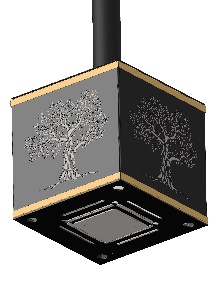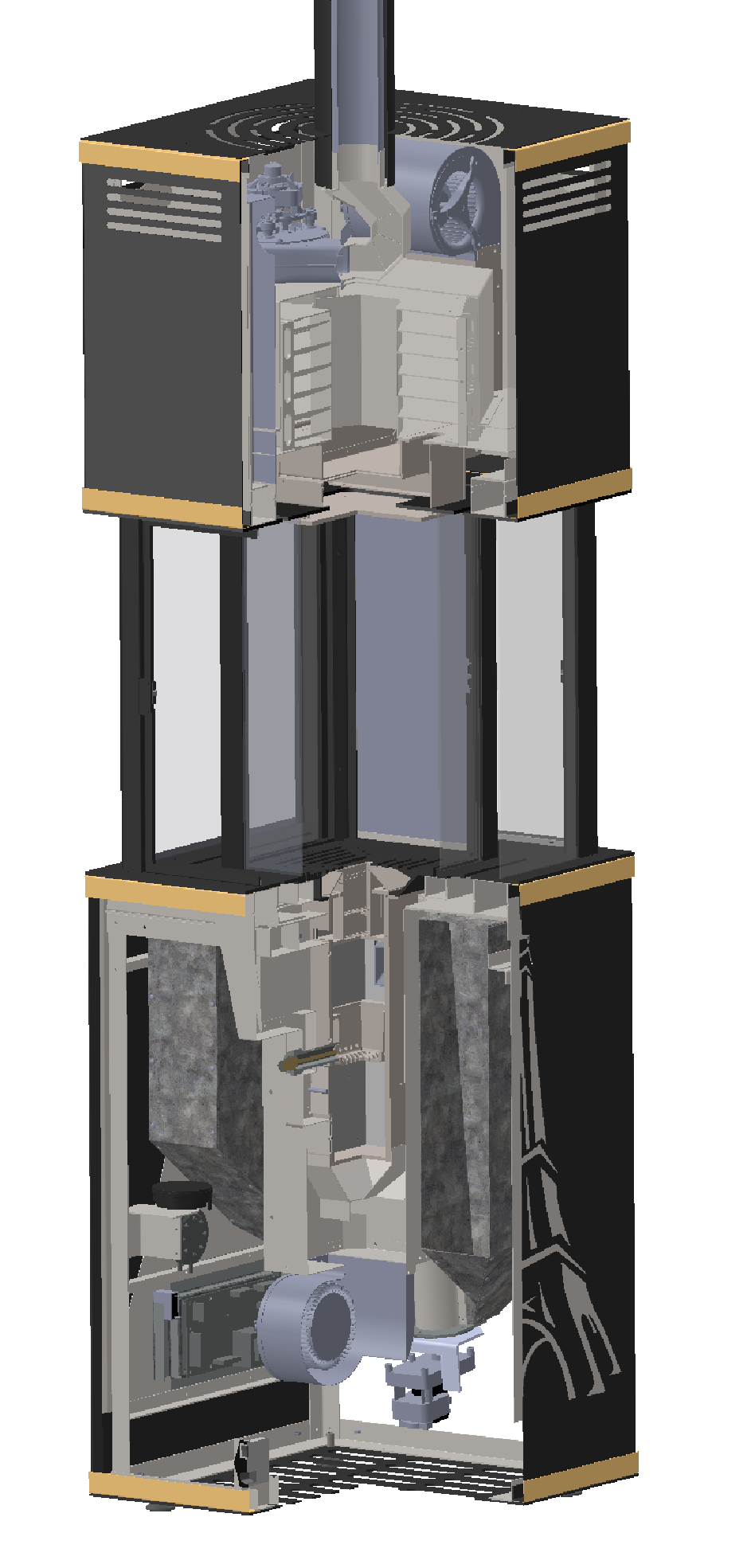Poêle V14
SCHULHOF PELLET STOVE
1) A stove in three parts
The characteristics of the combustion concept by feeding the wood pellets below the level of visibility of the flame has resulted in a design allowing 360° visibility of the flame around the stove, either visibility from 4 sides or 3 or 2 sides by blocking off the other sides.
With a base area of 54 x 54 m, a height of 1.9 m and a weight of 120 kg, its architecture and design is divided into three parts:
1) The top section:
- 580 mm high with a side section of 540 mm.
- It includes a specific heat exchange and smoke treatment system that generates a flow of hot air independent of that in the lower section.
- The oxygen level is measured by a Lambda probe.
2) The central section provides 360° visibility of the flame around the stove:
- With a height of 500 mm, it comprises two sectors of glass that are concentric one inside the other.
- The flame is central and visible from all 4 sides of the stove.
- 3 doors: 1 for the combustion section and 2 for the peripheral section.
- The flame and smoke outlets are in the centre.
- Hot air circulates between the two panes of glass, from the bottom-up combustion system, which heats up as the 4 central panes of glass heat up.
3) The lower section:
- 850 mm high with a side section of 540 mm The tank with a capacity of 37 kg
- The combustion system, which is totally sealed from its surroundings,
- Part of the electrical and electronic components with Initial production of hot air.
- Reception and centralisation of the overall air flow from the upper section.
DIFFERENCES FROM CURRENT PRODUCTS
To define the product in relation to the current market, ask yourself two questions
|
QUESTIONS |
ANSWERS |
|
What does this new product have in common with current pellet stoves? |
NOTHING |
|
What makes this new pellet stove different from the current pellet stoves? |
ALL |
DIFFERENCES BY CATEGORY
|
CURRENT STOVE MODELS THE |
V14 MODEL |
|
THE COMBUSTION CONCEPT |
|
|
Stoves are organised in such a way that combustion is generated in a crucible located in the part of the firebox that is visible to the user. The resulting flame cannot undergo any other treatment, such as the injection of a second flow of air at a height of around 250 mm, to generate a true second combustion. In today's stoves, the flame is contained in a firebox consisting of a glass door on the front and a structure, often metal, on the other three sides. |
In the V13 and V14 stoves, combustion is initiated well below the visible part of the flame, allowing a second flow of air to be efficiently injected, generating a second combustion by igniting the unburnt residual gases still contained in the first combustion. (Patent) This combustion system includes a filter (patent) responsible for retaining the unburnt particles projected by the first flame in order to re-burn them as combustion continues. |
|
THE SIZE OF THE FIREBOX AND THE VISIBILITY OF THE FLAME |
|
|
For reasons of economy and physico-chemical performance imposed by the standard, the hearth of today's stoves is increasingly small and narrow, allowing less and less of the flame to be seen. |
The V14 stove offers 360° visibility of the flame around the stove, with a flame height of 500 mm at 9 kW. |
|
THE TANK |
|
|
The tank holds between 12 and 23 kg at most, which means limited autonomy in very cold weather. |
The tank capacity of the V13 stove is 52 kg, and 37 kg for the V14, i.e. 7h45 at full power and 2.4 times the average volume. |
|
THE NOISE |
|
|
Today's stoves are often noisy, mainly due to the noise made by the pellets as they fall into the crucible, as well as the stove's control constraints and architecture, which mean that to achieve the desired power and efficiency, medium-quality fans have to be turned at high speed, which generates more noise as a result of the vibrations generated by the rotation of the drum, as well as the speed of the aeraulic flows concerning the smoke and the production of hot air in a small, confined space. |
The pellet supply to the combustion system is designed to be totally silent. The V14 stove has two hot air flows with two centrifugal fans, each of them oversized to turn more slowly (300 rpm) and therefore be practically inaudible. The hot air flow, like that of the smoke, is rising, generating a natural convection flow that requires little support. |
|
HOT AIR FLOWS AND EFFICIENCY |
|
|
Because of the size of the stove and its structure, efficiencies are between 87% and 89% for outputs of 8 to 9 kW and 90% to a maximum of 91% for outputs of 5 to 6 kW. |
Because of the afterburner and the double hot air circuit (top and bottom) created around the combustion system at the bottom and around the flue gas heat exchanger, the efficiency is 93/94% (more expected for the V14). At this level of efficiency (over 90%), each point gained requires much more efficiency and performance in operation than the point gained between 80 and 90% efficiency. |
|
AFTERBURNING |
|
|
There is no afterburner in the traditional stove, which has existed since its origin. |
For the first time in a pellet stove, a true second combustion is used, with the air that generates it being raised to a temperature of 300°C or more after approximately 45 minutes of operation, which is physically fundamental to the efficiency of the post-combustion. This explains the very high level of efficiency. |
|
FLUE GAS OUTLET AND DIMENSIONS |
|
|
In entry-level products, the outlet is always horizontal at the rear, which means that the stove has to be moved forward and the glass has to be about 70 cm from the wall, which can be a problem in rooms with limited space. |
For both models, the outlets are vertical and on top, and the stove can be positioned just 5 centimetres from the wall. |
|
MAINTENANCE / USE AND SOILING OF WINDOWS |
|
|
The use of today's stoves means that the unburnt residue spread around the crucible has to be cleaned more or less quickly, depending on how often it is used. This generates dust and takes time.
Depending on the length of time the stove is used, the number of times it is switched on, the power output and the composition in % of hardwood and softwood, the glass becomes clogged more or less quickly and to a greater or lesser extent. |
A curtain of air blown underneath and to either side of each glass pane limits clogging. The filter positioned in the combustion system considerably limits the projection and fallout of unburnt components around the flame outlet. The second flame and its temperature resulting from gas combustion carry little or no unburnt fatty residue. A computerised control system based on information about the oxygen content of the combustion delivered by a lambda sensor enables the combustion and post-combustion air to be modulated during the various phases of use, helping to sublimate unburnt residues at high temperature. |
|
SHAPE, MATERIALS AND CLADDING |
|
|
En fonction de la taille du poêle et de ses matériaux d’habillage la gamme de qualité varie mais le concept reste toujours le même.
|
The V14 model is available in a range of cladding materials in a variety of colours, as well as a range of designs for the panels on all four sides of the parallelepiped-shaped stove. |
PHYSICAL AND CHEMICAL COMBUSTION CHARACTERISTICS OF THE V14 STOVE
- Thanks to the addition of a real afterburner function, flame temperatures of between 600 and 1,200°C can be achieved, depending on the power output.
- Very little unburnt organic residue
- A CO emission level (13% O2) of 0.01% NCP, i.e. -75% compared to the standard threshold.
- An efficiency of over 93%, i.e. +94% compared to the standard threshold.
- Fine dust emissions of less than or equal to 8mg/Nm3, i.e. -84% compared to the standard threshold.
- Two power levels, 6 and 9 kW (rated power: 9kW)
- Watertight, with CSTB technical approval.
- Smoke outlet concentric with combustion air inlet, vertical on top
- Very limited soiling of glass panes.
- Pellet feed auger mounted on 2 ball bearings, totally silent operation.
- No or very little ash deposits around the flame outlet.
- Very quiet.

